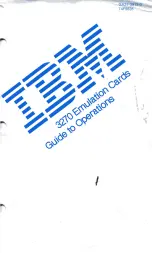
Chapter 6
Calibrating Images
IMAQ Vision for Visual Basic User Manual
6-8
ni.com
Note
A high score does
not
reflect the accuracy of the system.
If the learning process returns a learning score below 600, try the following:
1.
Make sure the grid complies with the guidelines listed in the
Defining a Calibration Template
section.
2.
Check the lighting conditions. If you have too much or too little
lighting, the software may estimate the center of the dots incorrectly.
Also, adjust the threshold range to distinguish the dots from the
background.
3.
Select another learning algorithm. When nonlinear lens distortion is
present, using perspective projection sometimes results in a low
learning score.
Learning the Error Map
An error map helps you gauge the quality of the complete system. The error
map returns an estimated error range to expect when a pixel coordinate
is transformed into a real-world coordinate. The transformation
accuracy may be higher than the value the error range indicates. Set
CWIMAQLearnCalibrationOptions.LearnErrorMap
to
True
to learn
the error map.
Learning the Correction Table
If the speed of image correction is a critical factor for the application, use
a correction table. The correction table is a lookup table that contains
the real-world location information of all the pixels in the image. The
correction table is stored in memory. The extra memory requirements for
this option are based on the size of the image. Use this option when you
want to simultaneously correct multiple images in the vision application.
Set
CWIMAQLearnCalibrationOptions.LearnCorrectionTable
to
True
to learn the correction table.
Setting the Scaling Mode
Use the scaling mode option to choose the appearance of the
corrected image. Set
CWIMAQLearnCalibrationOptions.CorrectionScalingMode
to
cwimaqScaleToFit
or
cwimaqScaleToPreserveArea
. For more
information about the scaling mode, refer to Chapter 3,
System Setup and
Calibration
, in the
IMAQ Vision Concepts Manual
.
















































